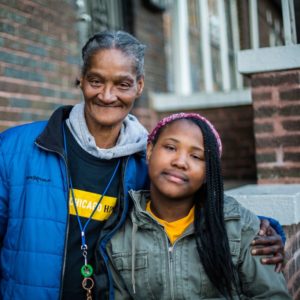She’s 11 years old and one of 17,000 homeless Chicago Public Schools students. She’s pre-diabetic, asthmatic and her neighborhood has the highest number of coronavirus cases in Illinois.

By Nader Issa
For the first three months, it was a park bench by Douglas Park on the West Side.
Then her older sister’s apartment in Homan Square.
Three different places in Englewood. One over in Gresham.
In all, Mariah Bingham has lived in 13 different places since she was born. She’s likely to be on the move again in the coming months.
She’s 11 years old and one of 17,000 homeless students at Chicago Public Schools.
LINK to the Sun-Times feature and photos
Mariah’s going into the home stretch of fifth grade having already gone to seven schools, never with a stable learning environment.
Now the coronavirus has taken over, and Mariah feels she might take a step back academically.
That’s not to mention the health concerns: Mariah and her mother are both asthmatic. Her mom is diabetic, Mariah, pre-diabetic.
“I am terrified of the coronavirus,” Mariah says, “because I love my life.”
‘I think I’m going to fall behind’
Mariah stood over a dining room table in early March before schools closed, soda in hand, showing off her neon pink poster plastered with facts about women’s rights activist Sojourner Truth. Mariah was humble, even reluctant to share, but she took pride in her work.
“She just showed she had to fight for what she wanted,” Mariah said of Truth, the figure she picked for her Black History Month project.
Things have changed in the weeks since, and Mariah and her 56-year-old mother, Margaret, have had to keep fighting.
The middle of March marked one year for her at Harvard Elementary, a school on the border of Englewood and Gresham that officials identify as needing extra support. Harvard serves almost entirely black students from low-income families.
Mariah was making progress in school, focusing on her favorite subject, math, and had developed a close-knit group of friends.
But when schools closed, Mariah was left without access to a computer or reliable internet.
“Honestly, I think I’m going to fall behind, definitely,” she said. “I’m kind of scared because if I don’t learn all that I need … it’s gonna be hard for me to get to sixth grade.”
Mariah was sent home with a homework packet when classes stopped nearly a month ago. She finished it three days later and has been bored waiting for more work. CPS is set to start widespread remote learning Monday, and her class has geared up with an online program that teaches various subjects. But Mariah has had trouble following along on her tiny cellphone screen.
“How am I supposed to learn if I can’t even do anything?” she said.
Her mother is in touch with the principal at Harvard in hopes Mariah can be provided with a laptop. CPS is working on distributing 100,000 devices over the coming days and weeks, and students experiencing homelessness are among the priorities.
But the district estimates 115,000 kids need computers and acknowledges the problem can’t be fixed overnight. So for now, a student’s grade can’t be lowered during the closures. Failed or incomplete assignments might have to be made up later.
